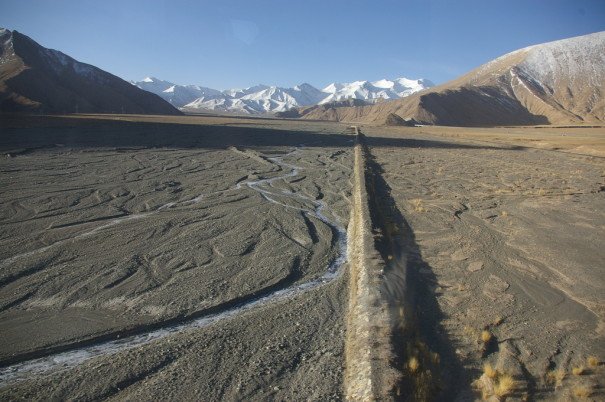
High-Altitude Hangover

High-Altitude Hangover
My first glass of Chinese wine – styling itself as a full-bodied red – delivered an instant, throbbing headache.
It was at a bar in Sanlitun. We got to Beijing overland, all the way from Lhasa by train. I had been travelling with a childhood friend overland through Nepal and Tibet for two months, writing the occasional travel piece for the small newspaper in London where I’d worked. I’d already written a series of articles based on train journeys, and I wanted to take the controversial Qinghai-Lhasa train. Opened the previous year in 2006, it was the first to connect China to Tibet.
The train route is an impressive but contentious feat of engineering. Laying tracks on frozen earth at around 40% less oxygen presented particular challenges, but at a cost of just under $4billion and with the help of high-tech innovation, China’s long-held dream of a direct route to Tibet was realised, and smashed some world records along the way. Stretching 4,000 km, the route includes the world’s highest railway pass at Tanggula Pass – 5,072 m (16,640 feet) above sea level, and it is also the world’s highest railway overall. For China, it was a glorious achievement fitting of their growing clout. But it was less good news for Tibet: exiles feared China would use the connection to assert its control over a contested region, flood Tibet with Han Chinese migrants (in the Tibet Autonomous Region, the one-child policy does not apply) and threaten Tibetan culture – already tenuously co-existing with the Chinese administration there.
In the train’s early days, I was told a passenger coming from Beijing died of altitude sickness because the train climbs too high too quickly from China’s mainland to the Tibetan plateau. Now oxygen is pumped into the cabins.
We came from the other side and had therefore already acclimated. In those days, from Kathmandu the only way to get to Tibet – officially – was on a group visa with a Chinese tour and your very own Chinese minder. We were ferried by bus from Kathmandu to the China-Tibet border, gaining altitude much faster than the human body is meant to. (Our route from Nepal to Tibet ascends steeply, then descends from the plateau towards Lhasa; the reverse journey would allow travellers to gradually acclimatize.)
A South Korean pilgrim was literally blue in the face for most of the first day. I had the worst headache of my life for two full days as my brain swelled, starved of oxygen in the thinner air. It felt like my brain was trying to launch itself out of my body through my forehead. I couldn’t sleep, despite the OTC Tamazepam (brand name: Valium) I bought in Nepal on a traveller’s recommendation. I spent an entire night vomiting. But after travelling over the Tibetan plateau, where in an altitude-addled state we got to see Everest in the distance, the worst was over as our journey took us downwards towards Lhasa.
After Nepal, Lhasa was a shock of Chinese modernity. “Lhasa Vegas” had wide boulevards redolent of American cities in the West. Chinese teenagers on mopeds swerved narrowly around circumambulating Tibetan pilgrims.
Lhasa train station was a silent monolith of clean lines and marble. The journey itself took 48 hours. The first 12 or so presented an endless display of jaw-dropping surface-of-the-moon tundra, bridges over teal glacial lakes, and lonely mountains. Once into China proper, we snaked through China’s new ghost cities and burning fields. When we were hungry, we went to the dining car. The waiter greeted us with “no” every time—I think because it’s the only English word he knew—so we simply pointed at other people’s plates. The train staff, first wary and then curious about our presence, bummed roll-up cigarettes from us and we tried to converse.
When we got to Beijing, we crashed for two days at a hostel in Dongcheng district, south of Tiananmen Square. After we woke up, we treated ourselves to a night out in Sanlitun. I was hoping for history-stained dens of iniquity; I got clean-lined cocktail bars. I ordered some wine. It tasted alright, but after only a few sips, it triggered an explosive headache—an unpleasant echo of the physical rigors of the high-altitude trip we’d just taken.
I understand that the wine has improved since that summer. The Chinese have developed a taste for the grape, and seem to be applying their stark eye-on-the-prize ambition and aspirations to becoming a wine superpower – although on this front at least, the goal seems to be more elusive.